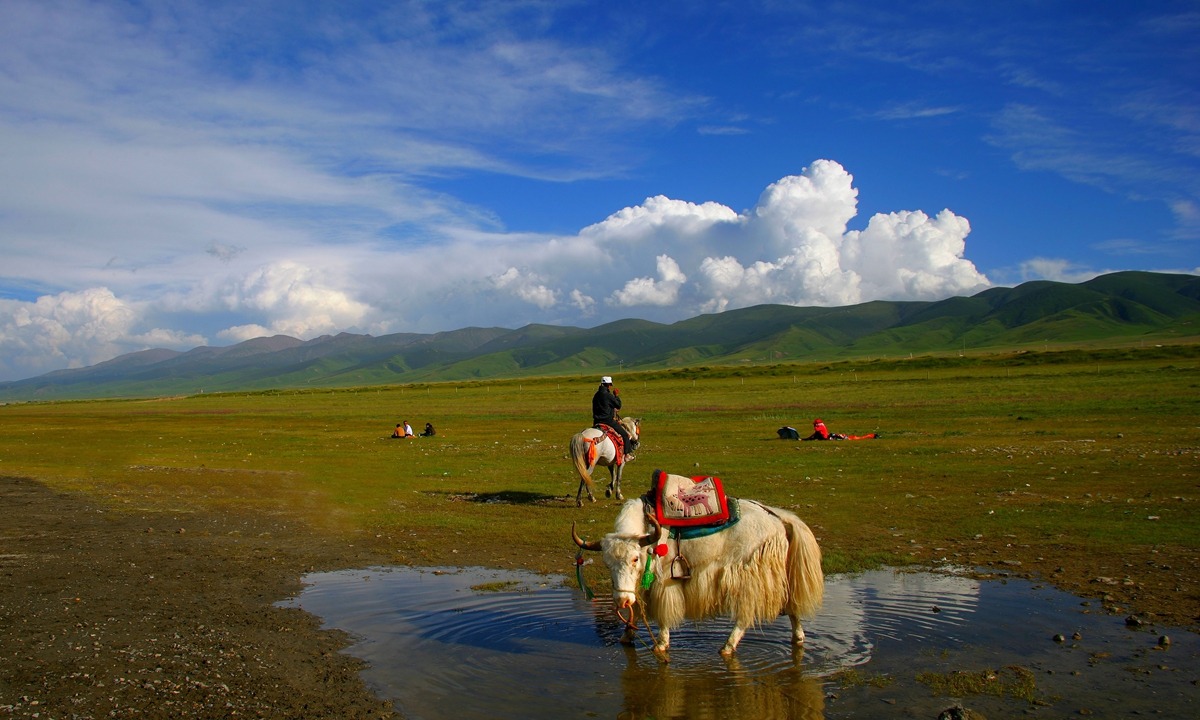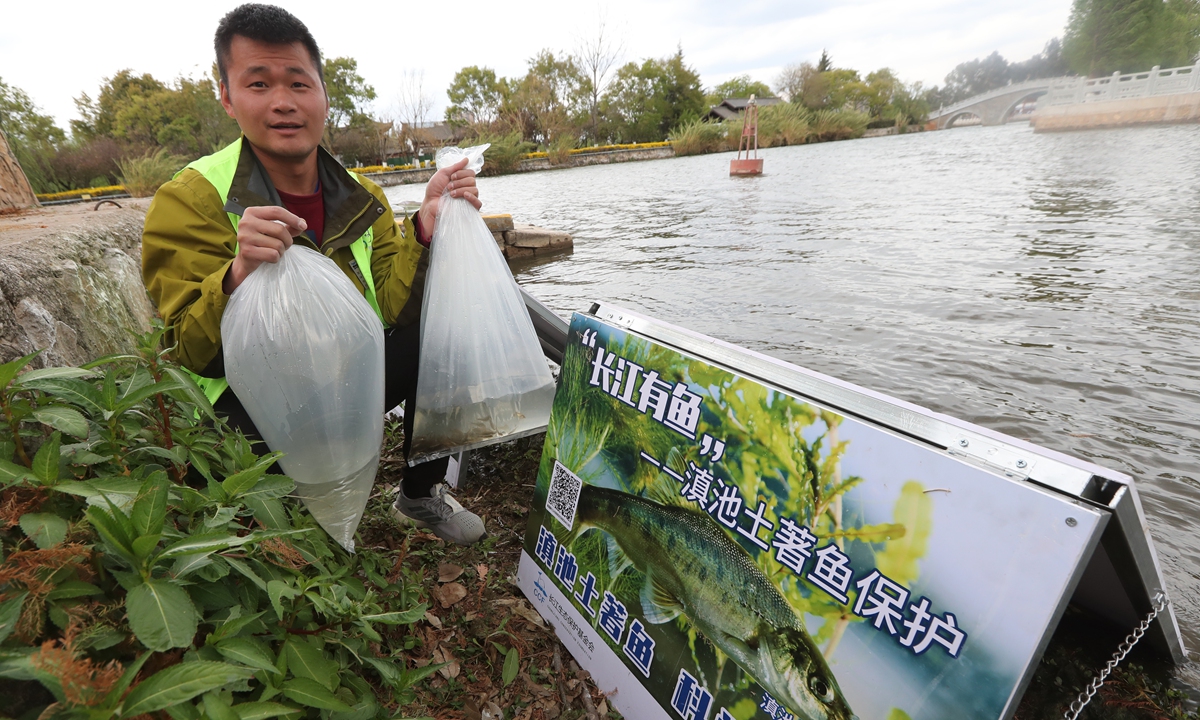The recent re-emergence of the old tune of attacking China’s normal water resources development and utilization has once again been used by the US and the secessionist Dalai Lama clique to smear China.
Media reported that during the recently concluded World Water Week Conference in Stockholm, the US State Department colluded with the Dalai Lama clique to attack and smear China’s water resources development and utilization on the Northwest China’s Qinghai-Xizang (Tibet) Plateau, known as “the roof of the world.”
They claimed that large-scale water diversion projects and hydropower development in the Himalayan region are having dramatic downstream consequences, including resulting in a lack of access to freshwater, economic disruption and negative impacts on downstream ecosystems.
A Global Times investigation found the opposite facts. Chinese water experts revealed that the rhetoric of the West and the Dalai Lama clique is completely unscientific and fabricated. In fact, in recent years, China has made great efforts and achievements in protecting water resources on the plateau, and has played a significant role in disaster prevention and reduction for downstream countries such as Laos and India.
Experts warned that outside forces deliberately creating hotspots by sensationalizing water resource issues to undermine cooperation between China and downstream countries are not in line with the common interests of riparian countries, nor do they contribute to the fundamental resolution of water usage.

Qinghai Lake National Nature Reserve contains a wealthy of beaches and wetlands. Photo: VCG
Groundless claims
In recent years, water diplomacy has become another battlefield in international relations and power struggles among major countries, especially with Western countries actively intervening in water resource security affairs in the Asia-Pacific region, aiming to make it an important leverage to influence regional affairs and contain China.
Claims such as “Chinese dams are destroying the Mekong River” and “China’s water projects in the Qinghai-Xizang Plateau are causing water shortages in Southeast Asian countries” have been continuously seen in Western media and so-called research groups.
Regarding these claims fabricated by the West, Jiang Yunzhong, director of the institute of water resources at the China Institute of Water Resources and Hydropower Research, told the Global Times that these rumors and smears from the West have no scientific basis. First, the water usage and consumption in the Qinghai-Xizang Plateau are relatively low, though maintaining excellent water quality, and have little effect on downstream countries’ water usage.
The annual average water resources in Xizang Autonomous Region and Qinghai Province combined exceed 500 billion cubic meters, but the water usage is less than 6 billion cubic meters, accounting for less than 1.2 percent of the water resources. It is one of the regions with the lowest utilization rate of mountain and water resources in the world, according to the expert.
The Qinghai-Xizang Plateau, with an area of around 2.58 million square kilometers, spans six provincial-level regions in western China. It is the source of several major rivers of Asia, such as the Yangtze, Yellow and Mekong rivers which together nourish around 3 billion people, according to the Xinhua News Agency.
Jiang further explained that the average precipitation in the Qinghai-Xizang Plateau is much less than that in downstream countries who have abundant water resources. The impact of water conservancy projects on downstream countries’ water sources, ecology, and economy is very limited. On the contrary, upstream reservoir regulation can better cope with regional extreme disasters.
Yao Wei, director of the planning department of water resources of CISPDR Corporation (Changjiang Institute of Survey, Planning, Design and Research Corporation), held a similar view. “In fact, the current utilization rate of water resources in the Qinghai-Xizang Plateau basin in China is still very low. The overall development and utilization rate of cross-border rivers in Southwest China is under 3 percent,” he noted.
In April, China passes landmark law to protect Qinghai-Xizang Plateau ecosystem, a new addition to China’s laws for special regions, following the enactment of the Yangtze River Protection Law, the Yellow River Protection Law, and the Black Soil Protection Law.
The new law outlines the overall layout of the plateau ecology security, stipulates protection and restoration measures, risk prevention and control, and safeguards and supervision.
It prohibits production and construction activities that may cause soil erosion in areas that already suffer severe soil erosion or have fragile ecology. It bans sand mining and mining activities that do not meet conservation requirements in nature reserves for river sources and imposes strict rules against the construction of new small hydropower stations on the plateau.
The law specifies that nature reserves should be established to protect rare, endangered or endemic wild animals and plants so that the authenticity and integrity of important natural ecosystems can be maintained.
Yao argued that in the development and utilization of cross-border rivers such as the Yarlung Zangbo River, China’s upstream reservoirs are mainly used for power generation and do not consume water. He stressed that due to the reservoirs’ obvious role in water regulation, reservoirs are beneficial to the downstream to a certain extent.
“Taking the Yarlung Zangbo River as an example, the development and utilization of water resources and hydropower in upstream China will not adversely affect the lower Brahmaputra River [which flows through Xizang, Northeastern India, and Bangladesh],” said Yao, “because the dams can control the peak discharge at the leave-boundary section during the flood season, which is beneficial to the flood control of the lower Brahmaputra River.”
Moreover, the water consumption in the Yarlung Tsangpo River Basin within China’s territory accounts for only 0.3 percent of the total basin, which is a very small proportion and does not affect the water use of downstream countries and regions. In terms of water quality, no pollutants are discharged during operation. On the contrary, China’s clear measures to protect soil and water can improve the water quality, said the expert.
Yao noted that the United Nations and the World Bank attach great importance to the development of hydropower, viewing it a clean and renewable energy source. Hydropower accounts for 80 percent of the world’s developed renewable energy, which contributes to sustainable poverty alleviation and effective reduction of greenhouse gas emissions.
“In fact, most industrialized countries have a relatively high rate of hydropower development. The claims hyped by some media that water resources development will result in the lack of access to fresh water, ecosystem harms, and economic damage in the downstream are putting the cart before the horse,” Yao said.

A volunteer releases golden-line barbel fries into the waters of Dianchi Lake in Yunnan on World Water Day, on March 22, 2023. Photo: IC
Neglected effort
In Jiang’s view, China has achieved positive results in water resource protection on the Qinghai-Xizang Plateau in recent years. “The abundant water resources on the plateau are located in deep valleys, with a dispersed population, making it difficult to develop and utilize water resources. The ecological environment is fragile, and water development started late. The Chinese government has launched many measures to protect the ecology of the plateau, and the governance capacity of rivers and lakes on the plateau has significantly improved.”
At the same time, in recent years, the Chinese government facilitates channels and communications with neighboring countries and established corresponding cooperation mechanisms. China holds consultations with neighboring countries at various levels every year and has carried out a large number of effective cooperation in providing flood season hydrological data, exchange visits, and emergency event handling.
“In terms of communication and information sharing with Mekong River countries, China has held dialogues with the Mekong River Commission every year since 1996,” Jiang introduced.
When severe floods occurred in Thailand in 2011 and Myanmar in 2015, the Chinese government sent flood control consulting expert groups upon invitation, and Chinese experts provided high-level consulting reports, which were highly praised by local governments and people, media reported.
In addition to water cooperation with Mekong River countries, China and India established the China-India Expert Level Mechanism on Trans-Border Rivers in 2007 to carry out cross-border water resource cooperation. Fourteen meetings have been held so far, and a memorandum of understanding on strengthening cross-border river cooperation has been signed.
According to experts, China has invested a large amount of manpower, material resources, and financial resources to overcome great difficulties in constructing hydrological stations in remote, inaccessible, and remote high-altitude mountainous areas. China has provided flood season hydrological data to India and effectively handled emergency events such as the landslide along the main trunk of the Yarlung Zangbo River in 2008 and the flood in the Yajiang River in 2018. These efforts have made positive contributions to disaster prevention and reduction downstream and have been recognized by leaders of both countries.
Intentions behind rumors
Faced with such facts, why does the US continue to spread rumors about China’s utilization and protection of water resources in the Qinghai-Xizang Plateau?
According to observations by Jiang, the US and the Dalai clique often employ the following methods: first, they release inaccurate satellite remote sensing monitoring data or reports regarding China’s hydropower projects; second, they recruit so-called independent journalists in downstream countries through funding and other means; third, they directly intervene in the affairs of the Mekong River region and establish the cooperative schemes with Southeast Asian countries; fourth, they publish misleading and one-sided commentaries or programs through websites, newspapers, books, and television, openly sowing discord between upstream and downstream countries.
“Many of the arguments they concoct are misleading or false,” Jiang said. He believes that the intentions behind the US and Dalai clique’s actions are very clear. They deliberately create hotspots by sensationalizing water resource issues to undermine cooperation between China and downstream countries, and sow discord between nations. Then they mislead the general public to blacken normal engineering construction, and affect regional stability and harmony.
However, these actions are not in line with the common interests of China and the countries in the region, nor do they contribute to the fundamental resolution of water resource issues, experts concluded.













